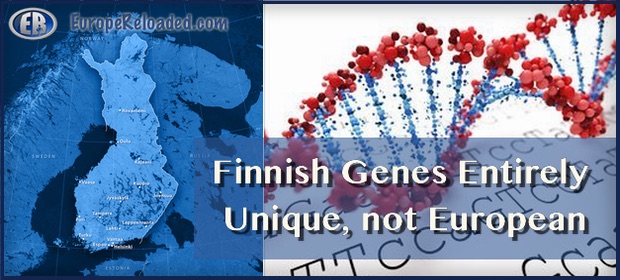
ER Editor: See also Finns Do Not Descend From Europeans, Reveals A New Study and Finns Found to be Genetically Unique, Genes Vary Significantly From Europeans.
********
The Uniqueness of the Finnish Race
.
The European peoples have long thought and felt that each of them was unique, reflecting the particularly history and struggles the successive generations of their ancestors. The cultural differences of European nations have long been known, but today, genetic science is also able to quantify just how unique each nation is from a biological point of view as well.
A paper published last year in Nature observed that most Europeans descend essentially from three ancestral populations:
European hunter-gatherers who settled the continent in the Upper Paleolithic, Europe’s first farmers who expanded from Anatolia across Europe in the early Neolithic
starting around 8,000 years ago, and groups from the Pontic Steppe (pictured) that arrived in Europe during the final Neolithic and early Bronze Age ~ 4,500 years ago.
Most Europeans’ ancestry can be broken down as a mix of these three ancestral populations. However, the paper adds:
This model, however, does not fit well for present-day populations from north-eastern Europe such as Saami, Russians, Mordovians, Chuvash, Estonians, Hungarians, and Finns: they carry additional ancestry, seen as increased allele-sharing with modern East Asian populations. The origin and timing of this East Asian-related contribution is unknown.
Hence the existence of so many amusing and tongue-in-cheek Finns-as-Mongols and Finns-as-Elves memes (in general, Elves are generally portrayed looking like northern Europeans with a dash of Oriental).
The Finns, Hungarians, and Estonians are unique in Europe in speaking Finno-Ugric languages. Most European nations speak Indo-European languages, descending from the original language of conquerors hailing from the Pontic Steppe. Genetic studies suggest that Finns are not just uniquely linguistically, but also genetically. Similarly, the Basque are the only other nation in Europe not speaking an Indo-European language and, as I have previously written, their region too appears to be genetically distinct relative to the rest of the French population.
In fact, any East Asian contribution to the Finnish gene pool long predates the Mongols and even the spread of Uralic languages in northern Europe. The scientists estimate that Siberian DNA was present in Finland at least 3,500 years ago.
The existence of a genetically-unique Finnish people has proven beneficial to humanity. A striking example of this is a study conducted by the Washington University School of Medicine which “harnessed the unique genetic history of the people of Finland to identify variations in DNA that might predispose certain individuals to disease, whether or not they are Finnish themselves.”
The Finns, having a unique gene pool, are much more likely to have certain genes predisposing to certain diseases. By analyzing Finnish genomes, the scientists were much better able to determine the correlations between genes and diseases. These genes and diseases are also present, albeit much less frequently, among other populations and hence the study of Finns is also beneficial to humanity’s health as a whole.
The researchers identified “26 potentially harmful DNA variations relevant to cardiovascular and metabolic health,” including genes raising the risk of obesity, diabetes, or high cholesterol levels. What’s more:
Of the 26 DNA variations identified, 19 are either unique to Finnish individuals or over 20 times more frequent in Finland compared with elsewhere in Europe.
Without this unique population — isolated and relatively genetically similar – the researchers estimate they would need to sequence the DNA of hundreds of thousands to millions of people to find these same associations, rather than the relatively manageable 20,000 individuals analyzed in this study.
Adam E. Locke, one of the researchers, observes that Finland has preserved its genetic uniqueness through low historic immigration:
The small population of people who first settled this part of the world – combined with relatively little immigration that would add variation to the gene pool – has pushed important genetic variants that first existed in the founding population to expand and become much more common than they would be elsewhere. Now we can delve into the patient data – which is extremely well-characterized through Finland’s national health-care system – to understand how these genetic variants influence overall health and disease risk in the people who have them.
We can then expect that this typically Nordic combination of genetic uniqueness and quality healthcare systems will prove beneficial to humanity as a whole.
Concerning physiognomy and health, no one denies that ethnic and racial groups have genetically-determined differences. Concerning the Finns:
Finland is a relatively isolated country, and with two major population bottlenecks over its history, the Finnish people have DNA more similar to one another than people in many other parts of the world. . . . The effect has produced a set of genetic diseases – called the Finnish Disease Heritage – that can occur anywhere but are much more common in Finland than in other European populations.
The Jews are another people – because of founder effects and generations of careful, religiously-sanctioned protection of their gene pool from foreign infiltration – uniquely prone to various diseases.
Still, while everyone recognizes physical and health differences due race and ethnicity, few openly discuss differences in physical and sporting ability, let alone cognitive ability and temperament. But it would be very strange if local human evolution affected populations’ physical appearance, their health, but not, curiously, their most important organ: their brain. No less than a miracle from some particularly egalitarian-minded God would be necessary. While average IQ differences between populations are well-documented, we have only barely scratched the surface temperamental differences.
The scientists add that other genetically-unique populations could be studied in this manner: “For example, communities of people living on islands such as Sardinia in Italy, Crete in Greece or the Samoan Islands in the South Pacific also might provide similarly genetically unique populations to study, and perhaps highlight some different yet universal aspects of human health.” All this is possible only because these ethnic groups were kept relatively separate.
Human beings used to be of the opinion that homogeneous nation-states and the preservation of distinct racial/genetic identities were goods for humanity. As late as 1958, an American judge upheld segregation laws writing:
Almighty God created the races white, black, yellow, malay and red, and he placed them on separate continents. And, but for the interference with his arrangement, there would be no cause for such marriage. The fact that he separated the races shows that he did not intend for the races to mix.
Decades earlier, and on a more Darwinian and secular note, the celebrated American horror novelist H. P. Lovecraft argued: “Race prejudice is a gift of nature, intended to preserve in purity the various divisions of mankind which the ages have evolved.”
Personally, I tend to think that human cultural diversity and achievement has been promoted by the existence of genetically distinct peoples – European, Middle-Eastern, Indian, East Asian, including subdivisions within these – and their interaction. Humanity would no doubt have been less fecund if we were made up only of one amorphous blob rather than various nations and peoples, each with their own unique cultural and biological heritage.
The genetic separation and uniqueness of many peoples, especially the Western, is unlikely to survive this century. There will, of course, still be White Americans, indigenous English, French, Finns, and so on, but, barring a political revolution, they will gradually lose their sovereignty and everything is going to get very muddled indeed over time.
Whatever one thinks of these developments, they are taking place based on the false assumption that race does not exist, that human populations are fully interchangeable, and that the genetic identity of the population is of no relevance to national character and prosperity. This tremendous change is occurring in a fit of mindlessness.
************
Original article

••••
The Liberty Beacon Project is now expanding at a near exponential rate, and for this we are grateful and excited! But we must also be practical. For 7 years we have not asked for any donations, and have built this project with our own funds as we grew. We are now experiencing ever increasing growing pains due to the large number of websites and projects we represent. So we have just installed donation buttons on our websites and ask that you consider this when you visit them. Nothing is too small. We thank you for all your support and your considerations … (TLB)
••••
Comment Policy: As a privately owned web site, we reserve the right to remove comments that contain spam, advertising, vulgarity, threats of violence, racism, or personal/abusive attacks on other users. This also applies to trolling, the use of more than one alias, or just intentional mischief. Enforcement of this policy is at the discretion of this websites administrators. Repeat offenders may be blocked or permanently banned without prior warning.
••••
Disclaimer: TLB websites contain copyrighted material the use of which has not always been specifically authorized by the copyright owner. We are making such material available to our readers under the provisions of “fair use” in an effort to advance a better understanding of political, health, economic and social issues. The material on this site is distributed without profit to those who have expressed a prior interest in receiving it for research and educational purposes. If you wish to use copyrighted material for purposes other than “fair use” you must request permission from the copyright owner.
••••
Disclaimer: The information and opinions shared are for informational purposes only including, but not limited to, text, graphics, images and other material are not intended as medical advice or instruction. Nothing mentioned is intended to be a substitute for professional medical advice, diagnosis or treatment.






